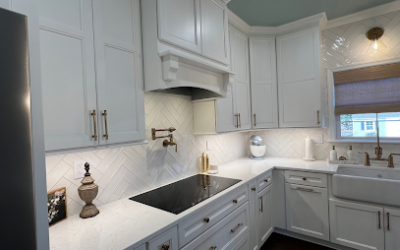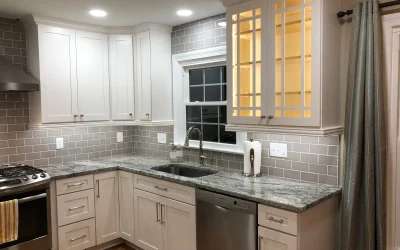Mid-century Modern Kitchen Design Elements
You may be planning to introduce mid-century design in your house. However, this is not a straightforward process. An understanding of materials, colors, and shapes associated with the style is essential. Here are the main design elements that you need to be aware of.
Break Out the Brick

Modern materials are popular within the design industry because they are long-lasting, affordable, and easy to maintain. Similarly, they have a high level of flexibility. Consequently, you can create any shape, style, or pattern using modern materials.
One of the first mid-century design elements to be created was the round dining table. It first appeared in the 1950’s, but it was not until 1965 when it adopted its current style. Round dining tables became popular because they were made from elastic and flexible materials. Today’s round dining tables have plastic, steel, aluminum, or plywood structures.
Mid-century modern stylists were the first designers to employ plasticity in the kitchen. They began toying with futuristic shapes in the mid-twentieth century. Unusual color combinations also appeared on the scene. While the original stylists used earthy hues, later stylists preferred Pop Art Trends.
Today, mid-century modern kitchen design embraces bright colors and fluid shapes. This unusual combination excites homeowners and interior decor designers.
Using New Materials
Manufacturers have been experimenting with new technological advances. Many of them have tried to combine different materials when creating new kitchen designs. For example, some mid-century modern kitchens have stone materials alongside non-traditional materials such as plywood and glass.
The floor of a mid-century modern kitchen is a marvel to look at. It is the first thing that designers work on before they move to other parts of the kitchen. When mid-century modern kitchen designs were first introduced, they usually featured stone materials, including bluestone and terrazzo. However, these materials were costly and difficult to work with.
Consequently, admirers of the design shifted to tile. Tile designs have a similar look, although their prices are much better. In the process, additional materials such as plywood and wood have also been used on some mid-century kitchen floors.
LATEST BLOGS
From Dull to Dazzling: The Power of a White Cabinet Kitchen Makeover
BLOG / KITCHENFrom Dull to Dazzling: The Power of a White Cabinet Kitchen Makeover White cabinet kitchens have held their place for decades, and for good reason. Their clean lines and bright tones bring clarity and structure to one of the most-used spaces in any home....
Upgrade Your Space with Custom Kitchen Cabinet Wood: A Homeowner’s Guide
BLOG / KITCHENUpgrade Your Space with Custom Kitchen Cabinet Wood: A Homeowner's Guide At Leo Lantz Construction, we understand that your kitchen is more than just a place to prepare meals; it’s the heart of your home. From hosting family dinners and catching up over...
Brighten Your Kitchen with Timeless White Cabinets and Make It a Space You Love
BLOG / KITCHEN If you’ve ever thought, “I’m embarrassed to have people over because of my kitchen,” you’re not the only one. We hear this all the time from homeowners, and helping people go from frustrated to proud of their space is one of the most rewarding parts of...
Kitchen Remodel: Smart Design Choices for a More Functional and Stylish Space
BLOG / KITCHEN A well-thought-out kitchen layout is the foundation of a successful remodel. The placement of key elements such as the sink, stove, and refrigerator should promote an easy workflow. The work triangle concept remains a reliable strategy, ensuring minimal...
SUBSCRIBE AND FOLLOW




Wood Cabinetry
Mid-century design favors wood cabinetry over other types of cabinets. The rustic simplicity is a welcome feature because it promotes the flexibility theme of mid-century designs.
Wood cabinets disappeared towards the end of the twentieth century, but they’re making a big comeback. Observers believe that their lower price could be their saving grace. At the same time, there are several types of wood species for homeowners.
Glass Cabinetry
You need a design that can display your collectibles in the most attractive manner. Sometimes, mid-century design involves glass cabinetry. Glass cabinetry uses glass on either side of the cabinet. Visitors can see your collectibles when they are in the kitchen or in the living area.
Exposed Brickwork
Cabinetry is not the only thing that you should think of when going for mid-century kitchen design. Perhaps you should take another look at your home’s walls. Walls can offer inspiration if they contain the right elements.
There are some unique textures and dimensions that come to the forefront when bricks and stones are not hidden behind plaster. Mid-century kitchen designers exposed the brickwork because they believed that it would create a traditional statement.
Bold Colors
Combining bold colors to create a striking kitchen is the mainstay of mid-century kitchens. Turquoise and green are popular among designers, especially when you have a white dining set. It’s also common for white and black chequerboard floors to be used when creating bold color combinations. The ultimate purpose is to introduce a playful pattern to your home.

Casual Breakfast Nook
Mid-century designs contain long-term, timeless styles. Furniture that can remain functional for a long time is not only stylish, but also financially efficient. For instance, you should use a vintage teak dining table in the middle of a mid-century kitchen design. Additionally, the kitchen floor can be adorned in a specific tile pattern.
Conclusion
Your kitchen has and will always remain the center of your home. It will create memories for your family for many years to come. If you believe in tradition, then the mid-century kitchen design can be the right option for your home. It is welcoming, stylish, and easy to maintain. Similarly, it provides enough space for culinary storage. More importantly, it gives you the flexibility to incorporate other types of kitchen design styles.
What defines a mid-century modern kitchen design?
Mid-century modern kitchens emphasize clean lines, functional design, and a mix of natural and manufactured materials. They often feature wood cabinetry, bold color contrasts, geometric shapes, and open-plan layouts.
What colors work best in a mid-century modern kitchen?
Bold colors such as turquoise, green, mustard yellow, and burnt orange are commonly used. These are often paired with neutral tones like white, black, or wood finishes to create balance.
What types of cabinetry are best suited for a mid-century modern kitchen?
Wood cabinetry is a signature feature of mid-century modern kitchens. Glass cabinetry is also popular, as it allows for displaying collectibles while maintaining a clean, open aesthetic.
What flooring options are ideal for a mid-century modern kitchen?
Traditional options include terrazzo, bluestone, and wood. More affordable alternatives like tile and plywood are also commonly used to achieve a similar look.
How can I incorporate exposed brickwork into my kitchen design?
Exposed brickwork is a key mid-century design element that adds warmth and texture. You can incorporate it by leaving one wall unplastered or using faux brick panels for a similar effect.
What furniture works well in a mid-century modern kitchen?
Furniture with sleek, tapered legs and organic shapes, such as round dining tables, vintage teak tables, and built-in breakfast nooks, are excellent choices for a mid-century modern kitchen.
Can mid-century modern design work with contemporary kitchens?
Yes! Mid-century modern elements blend well with contemporary designs by incorporating geometric shapes, minimalist cabinetry, and warm wood tones while using modern appliances and lighting.
How can I create a casual breakfast nook in a mid-century modern kitchen?
A breakfast nook with a simple yet stylish built-in bench, a round dining table, and colorful seat cushions creates a cozy space while maintaining the mid-century aesthetic.
What materials are commonly used in mid-century modern kitchen countertops?
Quartz, terrazzo, and laminate countertops are often seen in mid-century kitchens. These materials provide durability while keeping a retro-inspired look.
How can I add lighting that fits a mid-century modern kitchen?
Pendant lights, globe fixtures, and sputnik chandeliers are perfect lighting choices for a mid-century modern kitchen. These options highlight the clean lines and bold aesthetics of the style.



